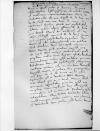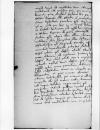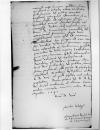Quae de fratribus istis ad me scripsit Reverendissima Dominatio Vestra, ea lecta sunt per me reverendissimo domino meo, domino ⌊Chelmensi episcopo⌋. Sicubi res postulabit, studium meum atque officium Reverendissimae Dominationi Vestrae non deerit. Quae hic acciderint, etsi ex aliis fortasse cognovit Reverendissima Dominatio Vestra, tamen ipse quoque perscribenda ea putavi. Dies decem et octo intercesserunt, cum publice fuit obiectum domino ⌊Sborowski⌋ nomine
s(erenissimae) or s(acrae)⌈s(erenissimae)s(erenissimae) or s(acrae)⌉
⌊maiestatis regiae⌋, quod quaedam dixisset, quae ad laesae maiestatis crimen pertinerent, quod quasdam contra serenissimum ⌊regem adolescentem⌋ coniurationes moliri esset auditus. ⌊Qui⌋ cum delatorem dari sibi postulasset sibique ne cogitare quidem ista in mentem venisse dixisset, neque se putare fore quemquam, qui haec in os sibi dicere ausus esset. Responsum est ⌊ei⌋ verbis
s(erenissimae) or s(acrae)⌈s(erenissimae)s(erenissimae) or s(acrae)⌉
⌊maiestatis regiae⌋: Cras aderit, qui in os dicat. Magna fuit hominum exspectatio, quorsum esset res evasura. Cum crastinus dies illuxisset, nuntiatum est, in diluculo ⌊Pretwicz⌋ esse interfectum. Qui tribus bombardis ictus multorumque gladiis petitus, cum strenue se defenderet, aegre quidem, sed vivus tamen  BCz, 1615, p. 190 evasit. Venit ad constitutum diem ⌊Sborowski⌋, postulavit sibi proferri eum, qui in os ea diceret, quae fuissent hesterno die per
s(erenissimam) or s(acram)⌈s(erenissimam)s(erenissimam) or s(acram)⌉
⌊maiestatem regiam⌋ sibi obiecta: se innocentiam suam defendere paratum esse. Responsum hidden by binding⌈[m]m hidden by binding⌉ est ⌊ei⌋, quod ⌊qui⌋ haec in os fuerat dicturus hidden by binding⌈[s]s hidden by binding⌉, is letali vulnere sit affectus, suspicari hidden by binding⌈[ri]ri hidden by binding⌉
s(erenissimam) or s(acram)()⌈s(erenissimam)s(erenissimam) or s(acram)()⌉
⌊maiestatem regiam⌋, id opera ⌊Sborowski⌋ factum esse atque ideo illum sacramento paper damaged⌈[nto]nto paper damaged⌉ militari sive sponsione fidei obstringere paper damaged⌈[re]re paper damaged⌉. Obstrictusque est frequenti senatu, cum paper damaged⌈[m]m paper damaged⌉ omnibus ingrediendi potestas facta esset paper damaged⌈[esset]esset paper damaged⌉. Nihil actum est adhuc aliud. Quid porro futurum sit, nescimus. ⌊Pretwicz⌋ vivit hidden by binding⌈[vit]vit hidden by binding⌉ adhuc. Duo sunt globi iam e corpore extracti. Restat unus adhuc, qui si eximi hidden by binding⌈[mi]mi hidden by binding⌉ hidden by binding⌈[] hidden by binding⌉ posset, extra omne periculum futurus esset. Adhibetur omnis in curando eo diligentia. Si quis nomen alicuius istorum detulisset, qui manus ⌊ei⌋ attulerunt hidden by binding⌈[unt]unt hidden by binding⌉, proposita illi est merces mille florenorum. Sed neque delatus, neque captus est quisquam.
BCz, 1615, p. 190 evasit. Venit ad constitutum diem ⌊Sborowski⌋, postulavit sibi proferri eum, qui in os ea diceret, quae fuissent hesterno die per
s(erenissimam) or s(acram)⌈s(erenissimam)s(erenissimam) or s(acram)⌉
⌊maiestatem regiam⌋ sibi obiecta: se innocentiam suam defendere paratum esse. Responsum hidden by binding⌈[m]m hidden by binding⌉ est ⌊ei⌋, quod ⌊qui⌋ haec in os fuerat dicturus hidden by binding⌈[s]s hidden by binding⌉, is letali vulnere sit affectus, suspicari hidden by binding⌈[ri]ri hidden by binding⌉
s(erenissimam) or s(acram)()⌈s(erenissimam)s(erenissimam) or s(acram)()⌉
⌊maiestatem regiam⌋, id opera ⌊Sborowski⌋ factum esse atque ideo illum sacramento paper damaged⌈[nto]nto paper damaged⌉ militari sive sponsione fidei obstringere paper damaged⌈[re]re paper damaged⌉. Obstrictusque est frequenti senatu, cum paper damaged⌈[m]m paper damaged⌉ omnibus ingrediendi potestas facta esset paper damaged⌈[esset]esset paper damaged⌉. Nihil actum est adhuc aliud. Quid porro futurum sit, nescimus. ⌊Pretwicz⌋ vivit hidden by binding⌈[vit]vit hidden by binding⌉ adhuc. Duo sunt globi iam e corpore extracti. Restat unus adhuc, qui si eximi hidden by binding⌈[mi]mi hidden by binding⌉ hidden by binding⌈[] hidden by binding⌉ posset, extra omne periculum futurus esset. Adhibetur omnis in curando eo diligentia. Si quis nomen alicuius istorum detulisset, qui manus ⌊ei⌋ attulerunt hidden by binding⌈[unt]unt hidden by binding⌉, proposita illi est merces mille florenorum. Sed neque delatus, neque captus est quisquam.
Aliud quiddam accidit postridie hidden by binding⌈[die]die hidden by binding⌉ hidden by binding⌈[] hidden by binding⌉ diei Paschatis. Heremita quidam veste suae professionis indutus ascendit contionem hidden by binding⌈[em]em hidden by binding⌉ sub id ipsum tempus, quo sacrum illud maius erat cantandum, cum praesentes  BCz, 1615, p. 191 adessent ⌊serenissimi principes⌋, ac magna voce: „Audite”, inquit, „audite, audite. Deus non potest ferre diutius populi sui scelera, et quemadmodum olim sancto Ioanni Evangelistae, ita mihi nunc indigno revelare dignatus est, quod o written over u⌈uoo written over u⌉rbem universum gravioribus quam umquam antea plagis afficere statuit, incipient autem a sanctuario suo”. Magnus fuit omnium stupor, cum haec audirent. Habitus est pro deliro. Cumque dixisset quidam, qui proxime adstabat: „Quas profers fabulas”? „Non fabulas”, inquit, „sed rem certam narro. Putatis me insanire, sum mentis compos”. Detractus est postea per sacerdotem de cathedra iussu magnatum, quod multi tamen moleste ferebant. Praecipue, postquam cognoverunt, sacerdotem esse, magna sanctimonia vitae praeditum. Venit ad me eo ipso die vocatus; contuli cum eo non pauca: visus est mihi esse sanioris mentis, quam ex iis ipsis nonnulli, qui eum deturbari iusserant. Quaesivi ex illo, quid ex eo loco dicere statuisset.
BCz, 1615, p. 191 adessent ⌊serenissimi principes⌋, ac magna voce: „Audite”, inquit, „audite, audite. Deus non potest ferre diutius populi sui scelera, et quemadmodum olim sancto Ioanni Evangelistae, ita mihi nunc indigno revelare dignatus est, quod o written over u⌈uoo written over u⌉rbem universum gravioribus quam umquam antea plagis afficere statuit, incipient autem a sanctuario suo”. Magnus fuit omnium stupor, cum haec audirent. Habitus est pro deliro. Cumque dixisset quidam, qui proxime adstabat: „Quas profers fabulas”? „Non fabulas”, inquit, „sed rem certam narro. Putatis me insanire, sum mentis compos”. Detractus est postea per sacerdotem de cathedra iussu magnatum, quod multi tamen moleste ferebant. Praecipue, postquam cognoverunt, sacerdotem esse, magna sanctimonia vitae praeditum. Venit ad me eo ipso die vocatus; contuli cum eo non pauca: visus est mihi esse sanioris mentis, quam ex iis ipsis nonnulli, qui eum deturbari iusserant. Quaesivi ex illo, quid ex eo loco dicere statuisset.  BCz, 1615, p. 192 Narravit mihi somnium quoddam suum, quo fuerit ei ecclesiae ruina revelata. Quod somnium ut publice omnibus proferret, quinquies admonitum se in somno fuisse, ad extremum etiam horribiles minas adiectas fuisse, nisi paruisset. Datum fuit negotium per reverendissimum ⌊dominum Cracoviensem⌋ nonnullis, ut examinarent hominem atque una consultarent, num esset ad contionem admittendus. Ego quoque ad eam rem fui vocatus. Vidimus hominem magna vitae integritate et sanctimonia praeditum, querentem de vita impura praelatorum, quos per somnium istud admonitos Deus voluerit, ut resipiscerent. Decretum est tandem, quatenus idem ⌊reverendissimo domino⌋ probaretur, ut publice somnium suum proferret, sed prius id perscriptum ostenderet. Si potero, descriptum mittam Reverendissimae Dominationi Vestrae et quid postea erit actum, perscribam.
BCz, 1615, p. 192 Narravit mihi somnium quoddam suum, quo fuerit ei ecclesiae ruina revelata. Quod somnium ut publice omnibus proferret, quinquies admonitum se in somno fuisse, ad extremum etiam horribiles minas adiectas fuisse, nisi paruisset. Datum fuit negotium per reverendissimum ⌊dominum Cracoviensem⌋ nonnullis, ut examinarent hominem atque una consultarent, num esset ad contionem admittendus. Ego quoque ad eam rem fui vocatus. Vidimus hominem magna vitae integritate et sanctimonia praeditum, querentem de vita impura praelatorum, quos per somnium istud admonitos Deus voluerit, ut resipiscerent. Decretum est tandem, quatenus idem ⌊reverendissimo domino⌋ probaretur, ut publice somnium suum proferret, sed prius id perscriptum ostenderet. Si potero, descriptum mittam Reverendissimae Dominationi Vestrae et quid postea erit actum, perscribam.
Deum precor, ut Reverendissimam Dominationem Vestram quam diutissime servet incolumem et felicem. Cuius me hidden by binding⌈[e]e hidden by binding⌉ gratiae commendo.
 BCz, 1615, p. 190 evasit. Venit ad constitutum diem
BCz, 1615, p. 190 evasit. Venit ad constitutum diem  BCz, 1615, p. 191 adessent
BCz, 1615, p. 191 adessent  BCz, 1615, p. 192 Narravit mihi somnium quoddam suum, quo fuerit ei ecclesiae ruina revelata. Quod somnium ut publice omnibus proferret, quinquies admonitum se in somno fuisse, ad extremum etiam horribiles minas adiectas fuisse, nisi paruisset. Datum fuit negotium per reverendissimum
BCz, 1615, p. 192 Narravit mihi somnium quoddam suum, quo fuerit ei ecclesiae ruina revelata. Quod somnium ut publice omnibus proferret, quinquies admonitum se in somno fuisse, ad extremum etiam horribiles minas adiectas fuisse, nisi paruisset. Datum fuit negotium per reverendissimum 



